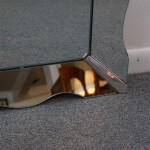Can You Mirror iPhone to TV Without Internet?
Mirroring an iPhone screen to a television offers a convenient way to share photos, videos, and presentations on a larger display. While internet connectivity simplifies this process through various streaming protocols, several methods enable screen mirroring without relying on an internet connection.
One widely used method involves Apple's proprietary technology, AirPlay. AirPlay utilizes a local Wi-Fi network to establish a direct connection between the iPhone and an Apple TV or a compatible smart TV. Although Wi-Fi is involved, an active internet connection isn't required. The iPhone and the receiving device need to be on the same local network, effectively creating a closed system for data transmission.
To initiate AirPlay mirroring without internet, users should ensure both the iPhone and the Apple TV or compatible smart TV are connected to the same Wi-Fi network. On the iPhone, access the Control Center by swiping down from the top-right corner (iPhone X and later) or swiping up from the bottom edge (older iPhones). Tap the "Screen Mirroring" icon and select the desired Apple TV or smart TV from the list of available devices.
For users without an Apple TV, several hardware solutions facilitate mirroring without internet. Adapters like HDMI cables with Lightning connectors directly connect the iPhone to the TV's HDMI port. These adapters provide a wired connection, bypassing the need for a network entirely. The iPhone's display is replicated on the TV screen, mirroring content in real-time.
Another hardware-based approach utilizes devices that create a local wireless network. Some streaming devices or dedicated mirroring hardware create their own Wi-Fi hotspots. The iPhone connects to this ad-hoc network, and the device transmits the mirrored content to the TV via HDMI. This method effectively replicates AirPlay functionality without needing a pre-existing Wi-Fi infrastructure.
When selecting an HDMI adapter or a wireless mirroring device, compatibility with the iPhone model and the TV's resolution is crucial. Certain adapters might support specific iPhone generations or offer varying video output resolutions. Checking the manufacturer's specifications ensures optimal performance and compatibility.
While the above methods offer screen mirroring without an active internet connection, they do have limitations. AirPlay, even without internet, still requires a functional Wi-Fi network. HDMI adapters might introduce latency or have limited resolution compared to wireless solutions. Devices creating local wireless networks can sometimes be susceptible to interference from other nearby devices operating on similar frequencies.
Beyond dedicated hardware solutions, certain apps facilitate mirroring through peer-to-peer connections. These apps create a direct link between the iPhone and a compatible receiver app on a smart TV or a connected device. This direct connection often relies on protocols like Bluetooth or Wi-Fi Direct, allowing screen sharing without the need for a router or internet access. However, the effectiveness and features of these apps can vary significantly.
DLNA-compatible devices and apps offer another potential route for mirroring content, though not true screen mirroring in all cases. DLNA (Digital Living Network Alliance) certified devices can share media files like photos and videos over a local network. While this doesn't replicate the entire iPhone screen, it allows for convenient playback of specific media content on a TV without internet. However, DLNA functionality depends on both the iPhone and the TV supporting the standard.
It is important to note that while these methods offer solutions for mirroring without an active internet connection, they still generally require some form of network infrastructure, whether it's a local Wi-Fi network, a direct wired connection, or a peer-to-peer connection facilitated through an app. The specific requirements and limitations of each method should be carefully considered based on individual needs and available equipment.
Finally, troubleshooting common mirroring issues involves verifying device compatibility, restarting devices, and ensuring software updates are current. For AirPlay, checking the Wi-Fi network configuration is essential. For wired connections, ensuring the integrity of the cables and adapters is crucial. If problems persist, consulting the manufacturer's documentation or support resources can provide further assistance.
Choosing the right method for mirroring an iPhone to a TV without internet depends on several factors, including the availability of compatible devices, desired resolution, and the specific type of content being shared. Understanding the limitations and advantages of each approach enables users to select the optimal solution for their individual needs.

How To Mirror Your Iphone Tv Without Wi Fi

Simple Ways To Mirror Iphone Tv Without Wifi 6 Steps

Simple Ways To Mirror Iphone Tv Without Wifi 6 Steps

Simple Ways To Mirror Iphone Tv Without Wifi 6 Steps

2024 Tutorial How To Mirror Phone Tv Without Wi Fi

3 Ways To Mirror Iphone Tv Without Apple Istreamer

How To Mirror Iphone Tv Without Wi Fi

How To Mirror Your Iphone Tv Without Wi Fi

How To Mirror Iphone Tv Without Apple

How To Screen Mirroring Any Android Phone Tv Without Wifi








